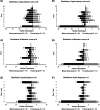MedXFit-Effects of 6 months CrossFit® in sedentary and inactive employees: A prospective, controlled, longitudinal, intervention study
- PMID: 35949685
- PMCID: PMC9358326
- DOI: 10.1002/hsr2.749
MedXFit-Effects of 6 months CrossFit® in sedentary and inactive employees: A prospective, controlled, longitudinal, intervention study
Erratum in
-
Corrigendum.Health Sci Rep. 2022 Nov 18;5(6):e944. doi: 10.1002/hsr2.944. eCollection 2022 Nov. Health Sci Rep. 2022. PMID: 36415566 Free PMC article.
Abstract
Background and aims: Sedentary behavior and physical inactivity are associated with musculoskeletal disorders (MSD). Muscle and mobility enhancing training is recommended to promote musculoskeletal fitness and prevent MSD. A functional fitness program emphasizing the importance of musculoskeletal fitness is provided by CrossFit®. However, data from long-term CrossFit® interventions assessing measures of musculoskeletal fitness in sedentary and inactive individuals does not exist.
Methods: This prospective, controlled study investigates the effects of 6 months CrossFit® training (2×60 min/week) in inactive adults (in terms of <2 muscle or mobility enhancing training sessions per week) with predominantly sitting or standing occupations. 91 participants were initially assessed, 2 were excluded, 55 self-selected for intervention (IG), and 34 for the control group (CG). Primary endpoint was a change in mobility (Functional Movement Screen score). Secondary endpoints were changed in strength (maximum isometric strength in kg; Dr. Wolff BackCheck®), and well-being (WHO-5 score). Key exploratory endpoints were changes in back-issue measures (pain intensity, limitation, and frequency).
Results: 39 participants of IG and 31 of CG completed the evaluation after 6 months. The IG improved significantly more (p < 0.001) compared with the CG in the FMS (η² = 0.58), trunk extension (η² = 0.46), trunk flexion (η² = 0.47), trunk lateral flexion left (η² = 0.41), trunk lateral flexion right (η² = 0.42), upper body push (η² = 0.4), upper body pull (η² = 0.25), hip extension left (η² = 0.18), and hip extension right (η² = 0.4). Change of WHO-5 scores did not significantly differ between groups (p = 0.55; η² = 0.01). Exploratory analysis of back-issue data showed a higher decrease for pain intensity, limitation, and frequency in the IG compared with the CG.
Conclusion: This study proves for the first time within the scope of a prospective, controlled study the broad benefits of CrossFit® in inactive adults doing predominantly sedentary work.
Keywords: exercise; fitness; functional movement; health; high‐intensity interval training; military.
© 2022 The Authors. Health Science Reports published by Wiley Periodicals LLC.
Conflict of interest statement
The results of this study are presented clearly, honestly, and without fabrication, falsification, or inappropriate data manipulation. The results of the present study do not constitute an endorsement by the American College of Sports Medicine. Professional relationships with companies or manufacturers who will benefit from the results of the present study do not exist. The authors declare that they have no conflict of interest.
Figures




Similar articles
-
CrossFit®: 'Unknowable' or Predictable?-A Systematic Review on Predictors of CrossFit® Performance.Sports (Basel). 2023 May 30;11(6):112. doi: 10.3390/sports11060112. Sports (Basel). 2023. PMID: 37368562 Free PMC article. Review.
-
The MedXFit-study - CrossFit as a workplace health intervention: a one-year, prospective, controlled, longitudinal, intervention study.Front Public Health. 2024 Feb 21;12:1304721. doi: 10.3389/fpubh.2024.1304721. eCollection 2024. Front Public Health. 2024. PMID: 38450146 Free PMC article. Clinical Trial.
-
Resistance exercise snacks improve muscle mass in female university employees: a prospective, controlled, intervention pilot-study.Front Public Health. 2024 Feb 6;12:1347825. doi: 10.3389/fpubh.2024.1347825. eCollection 2024. Front Public Health. 2024. PMID: 38379679 Free PMC article.
-
Effects of a 16-week Pilates exercises training program for isometric trunk extension and flexion strength.J Bodyw Mov Ther. 2017 Jan;21(1):124-132. doi: 10.1016/j.jbmt.2016.06.005. Epub 2016 Jun 16. J Bodyw Mov Ther. 2017. PMID: 28167168
-
Workplace interventions for increasing standing or walking for decreasing musculoskeletal symptoms in sedentary workers.Cochrane Database Syst Rev. 2019 Nov 17;2019(11):CD012487. doi: 10.1002/14651858.CD012487.pub2. Cochrane Database Syst Rev. 2019. PMID: 31742666 Free PMC article.
Cited by
-
CrossFit®: 'Unknowable' or Predictable?-A Systematic Review on Predictors of CrossFit® Performance.Sports (Basel). 2023 May 30;11(6):112. doi: 10.3390/sports11060112. Sports (Basel). 2023. PMID: 37368562 Free PMC article. Review.
-
Advanced ECG Analysis to Evaluate Multimodal Exercise Effects on Cardiovascular Health.Medicina (Kaunas). 2025 Mar 7;61(3):473. doi: 10.3390/medicina61030473. Medicina (Kaunas). 2025. PMID: 40142284 Free PMC article.
-
The MedXFit-study - CrossFit as a workplace health intervention: a one-year, prospective, controlled, longitudinal, intervention study.Front Public Health. 2024 Feb 21;12:1304721. doi: 10.3389/fpubh.2024.1304721. eCollection 2024. Front Public Health. 2024. PMID: 38450146 Free PMC article. Clinical Trial.
-
Physiological effects of regular CrossFit® training and the impact of the COVID-19 pandemic-A systematic review.Front Physiol. 2023 Apr 5;14:1146718. doi: 10.3389/fphys.2023.1146718. eCollection 2023. Front Physiol. 2023. PMID: 37089417 Free PMC article.
-
CrossFit Motivates a 41-Year-Old Obese Man to Change His Lifestyle and Achieve Long-Term Health Improvements: A Case Report.J Funct Morphol Kinesiol. 2023 May 8;8(2):58. doi: 10.3390/jfmk8020058. J Funct Morphol Kinesiol. 2023. PMID: 37218854 Free PMC article.
References
-
- World Health Organization Global action plan for the prevention and control of noncommunicable diseases. World Health Organisation; 2013:103. https://www.who.int/publications/i/item/9789241506236
-
- Wessinghage T, Morsch A. Muskel‐skelett‐erkrankungen: bedeutung von bewegungsmangel und sportlicher aktivität. Pub Health Forum. 2013;21(2):21‐22. https://www.degruyter.com/document/doi/10.1016/j.phf.2013.03.020/html - DOI
-
- Finger JD, Mensink G, Lange C, Manz K. Arbeitsbezogene körperliche aktivität bei erwachsenen in deutschland. J Health Monit. 2017;2(2):29‐36. https://www.rki.de/DE/Content/Gesundheitsmonitoring/Gesundheitsberichter...
-
- Garber CE, Blissmer B, Deschenes MR, et al. Quantity and quality of exercise for developing and maintaining cardiorespiratory, musculoskeletal, and neuromotor fitness in apparently healthy adults. Med Sci Sports Exer. 2011;43(7):1334‐1359. https://journals.lww.com/00005768-201107000-00026 - PubMed
-
- Bull FC, Al‐Ansari SS, Biddle S, et al. World health organization 2020 guidelines on physical activity and sedentary behaviour. Br J Sports Med. 2020;54(24):1451‐1462. https://bjsm.bmj.com/lookup/doi/10.1136/bjsports-2020-102955 - DOI - PMC - PubMed
LinkOut - more resources
Full Text Sources
Miscellaneous

